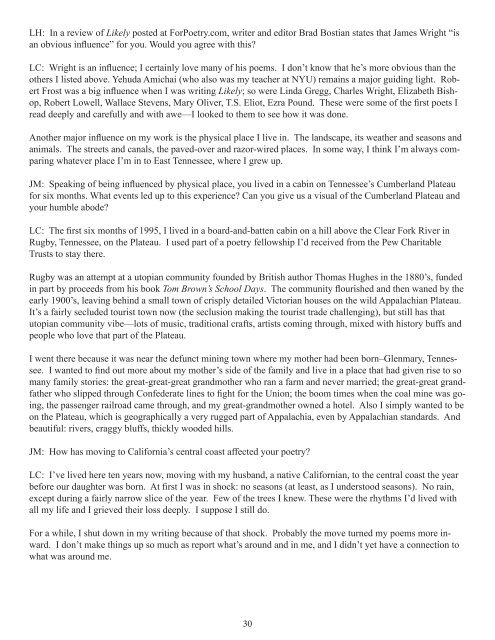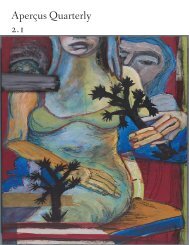Aperçus Quarterly 1.3
Aperçus Quarterly 1.3 - Apercus Quarterly
Aperçus Quarterly 1.3 - Apercus Quarterly
- No tags were found...
You also want an ePaper? Increase the reach of your titles
YUMPU automatically turns print PDFs into web optimized ePapers that Google loves.
LH: In a review of Likely posted at ForPoetry.com, writer and editor Brad Bostian states that James Wright “isan obvious influence” for you. Would you agree with this?LC: Wright is an influence; I certainly love many of his poems. I don’t know that he’s more obvious than theothers I listed above. Yehuda Amichai (who also was my teacher at NYU) remains a major guiding light. RobertFrost was a big influence when I was writing Likely; so were Linda Gregg, Charles Wright, Elizabeth Bishop,Robert Lowell, Wallace Stevens, Mary Oliver, T.S. Eliot, Ezra Pound. These were some of the first poets Iread deeply and carefully and with awe—I looked to them to see how it was done.Another major influence on my work is the physical place I live in. The landscape, its weather and seasons andanimals. The streets and canals, the paved-over and razor-wired places. In some way, I think I’m always comparingwhatever place I’m in to East Tennessee, where I grew up.JM: Speaking of being influenced by physical place, you lived in a cabin on Tennessee’s Cumberland Plateaufor six months. What events led up to this experience? Can you give us a visual of the Cumberland Plateau andyour humble abode?LC: The first six months of 1995, I lived in a board-and-batten cabin on a hill above the Clear Fork River inRugby, Tennessee, on the Plateau. I used part of a poetry fellowship I’d received from the Pew CharitableTrusts to stay there.Rugby was an attempt at a utopian community founded by British author Thomas Hughes in the 1880’s, fundedin part by proceeds from his book Tom Brown’s School Days. The community flourished and then waned by theearly 1900’s, leaving behind a small town of crisply detailed Victorian houses on the wild Appalachian Plateau.It’s a fairly secluded tourist town now (the seclusion making the tourist trade challenging), but still has thatutopian community vibe—lots of music, traditional crafts, artists coming through, mixed with history buffs andpeople who love that part of the Plateau.I went there because it was near the defunct mining town where my mother had been born–Glenmary, Tennessee.I wanted to find out more about my mother’s side of the family and live in a place that had given rise to somany family stories: the great-great-great grandmother who ran a farm and never married; the great-great grandfatherwho slipped through Confederate lines to fight for the Union; the boom times when the coal mine was going,the passenger railroad came through, and my great-grandmother owned a hotel. Also I simply wanted to beon the Plateau, which is geographically a very rugged part of Appalachia, even by Appalachian standards. Andbeautiful: rivers, craggy bluffs, thickly wooded hills.JM: How has moving to California’s central coast affected your poetry?LC: I’ve lived here ten years now, moving with my husband, a native Californian, to the central coast the yearbefore our daughter was born. At first I was in shock: no seasons (at least, as I understood seasons). No rain,except during a fairly narrow slice of the year. Few of the trees I knew. These were the rhythms I’d lived withall my life and I grieved their loss deeply. I suppose I still do.For a while, I shut down in my writing because of that shock. Probably the move turned my poems more inward.I don’t make things up so much as report what’s around and in me, and I didn’t yet have a connection towhat was around me.30



